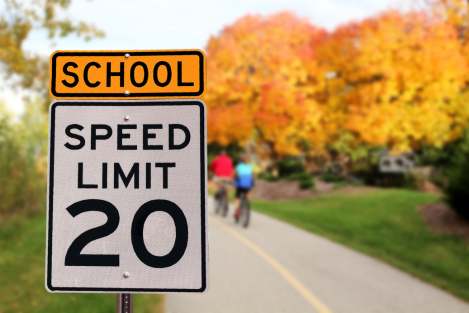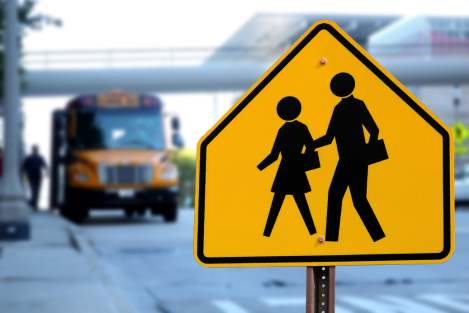
Written by Kayla Jane Barrie Updated on Nov 24, 2025 4 mins read

Community safety zones represent a collective commitment to ensuring the safety and well-being of residents and visitors. Although community safety zones have been implemented across the province, a 2019 CAA poll shows that 70% of Canadians witnessed speeding in school zones, which are designated community safety zones. Here we explore community safety zones, the fines, laws, and insurance impact so you can be a safer driver.
Community safety zones are specific sections of the road where public safety is a top priority. They are designated areas recognized under provincial legislation and marked with community safety zone signs.
The Highway Traffic Act empowers municipalities to designate particular areas as community safety zones. These zones enhance safety measures and protect vulnerable road users, particularly pedestrians and cyclists. They typically encompass spaces in close proximity to schools, parks, and other locations frequently visited by children and pedestrians. To promote responsible behaviour among motorists, these zones implement reduced speed limits and enhanced penalties for traffic violations.
Fines for traffic violations within the safety zones are doubled, and the use of an automated speed enforcement system is allowed through the applicable sections of Bill 65, Safer School Zones Act, 2017. The legal limits of these zones are marked with signs at the beginning and end and are in effect 24 hours a day unless otherwise posted. The primary objective of establishing these zones is to mitigate the risk of accidents, creating safer environments for everyone.
Community Safety Zones have different speed limits - paying attention to posted signage in the area is important. Some zones will be 40 km/h, while others may be as slow as 20 km/h.
If you drive along any residential areas or a road with schools nearby, you’ve likely seen signs for community safety zones. These areas were designed in 2012 to protect children on their way to school.
All fines in these zones are doubled, including driving over the speed limit and road sign violations. If your ticket would typically be $50, you would see it increase to $100. Fines will increase if you are fined for excessive speed in a community safety zone. Here is an overview of the fines:
Your fine will be doubled whenever you receive a ticket for breaking the law while driving in a community safety zone. This includes violations related to road signs, driving over the speed limit, and other infractions. For instance, receiving a $50 ticket would amount to $100 if you were driving above the speed limit in a community safety zone.
Community safety zone fines can result in an increase in your insurance and stay on your driving record.
Regardless of where you receive a traffic ticket, it will be recorded on your driving record, affecting your car insurance. The duration and extent of the impact will depend on the nature of the violation and the number of other violations you have accumulated. For example, you could see a higher spike if you are also texting and driving or partaking in distracted driving.
The length of time that fines continue to affect your insurance rate depends on the severity of the violation, but minor and major traffic convictions can impact your rate for up to three years, depending on how long they stay on your abstract.
Since different insurance providers have varying surcharges for specific fines, it's essential to compare your options regularly to ensure that you are getting the lowest premium for your circumstances. Additionally, once the ticket is cleared from your record, it's advisable to compare rates again.

The creation of community safety zones has resulted in concrete advantages for communities throughout Ontario. By prioritizing safety and implementing targeted measures, these zones have contributed to:
The implementation of safety measures within community safety zones involves a multi-faceted approach aimed at addressing various aspects of road safety. These measures may include:
A community safety zone is a designated area of higher risk identified by a municipal council through a by-law. In these zones, certain Highway Traffic Act fines (including speeding) are doubled, and they are often located near schools.
You bet! Some community safety zones may have photo radar enforced to catch drivers who neglect to slow down. Not all community safety zones have speed cameras – but you can always check online to find the locations, or even better, be a safe and considerate driver while you pay attention to road signs.
Speed limits in community safety are usually between 30-50 km/hr. Some locations may only be active during set hours (ie: 7:00 am to 4:00 pm Monday-/Friday), while others may be at all times of the week.
Ontario must adapt its approach to road safety. Community safety zones prioritize the safety of all road users and promote vigilance and responsibility. By collaborating with drivers, homeowners, and city planners, we can pave the way for a safer future on the roads, and lower Ontario car insurance rates.
| Categories | Auto |
|---|---|
| Tags | Driving Tips |
Read our insurance blog to get helpful tips, information and news.
Has your car been totalled in an accident? Is your car a write off? Learn about vehicle write offs for a total loss insurance claim.
Get the facts on Toronto's auto theft problem. We break down the data, reveal the most-stolen vehicles (including the Honda CR-V and Lexus RX 350), and show which neighbourhoods are most affected.
Dive into the world of auto theft with our blog on the most stolen cars in Canada. See the most stolen cars across Canada, including provincial lists for Ontario and Quebec, and learn how high-risk models can affect your car insurance premiums.
Drive safe this winter! Check out these tips for driving in snowy and icy conditions in Ontario. Get other helpful info and FAQs on winter driving.